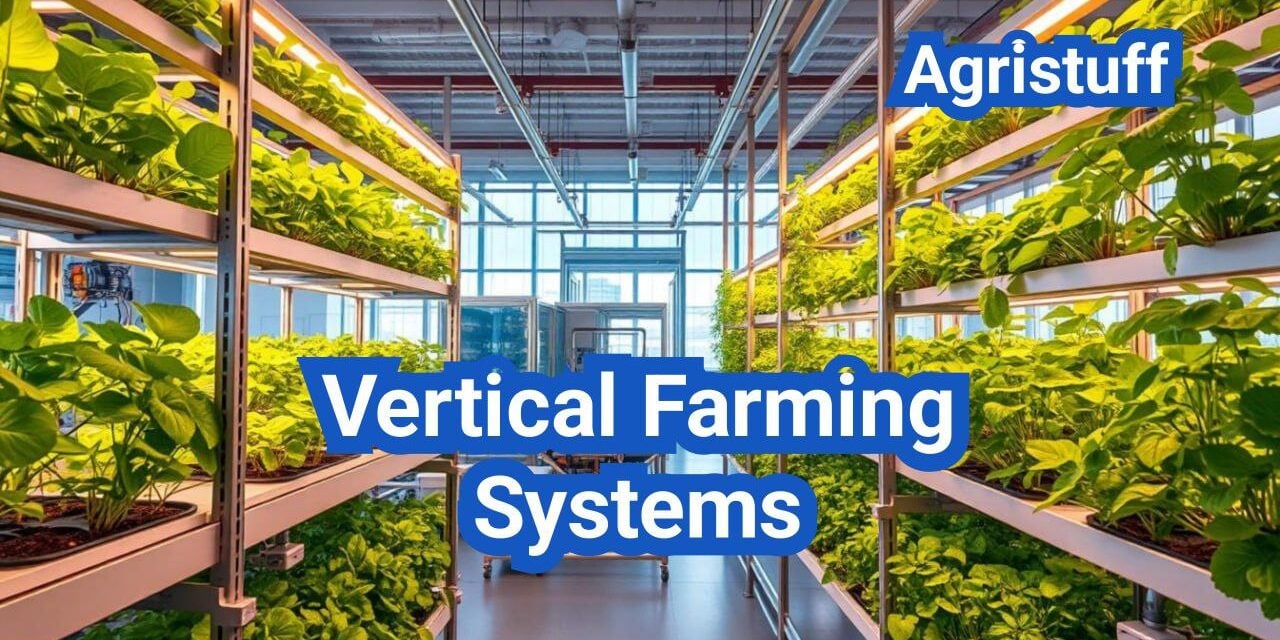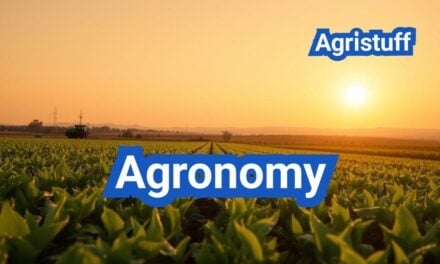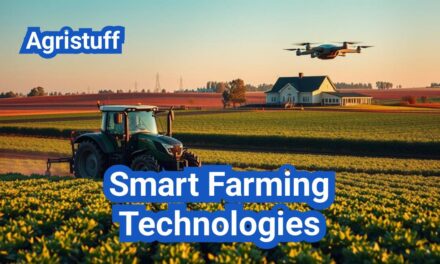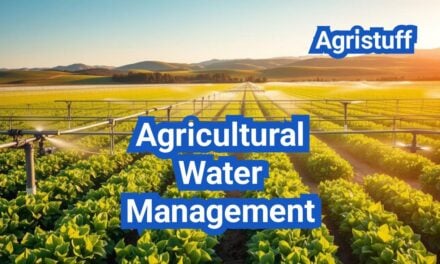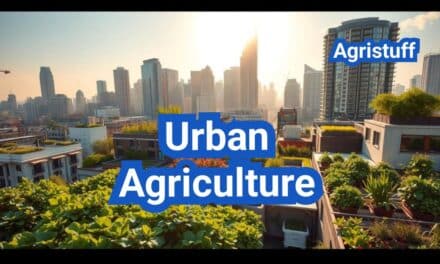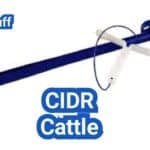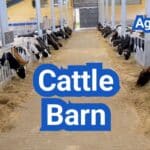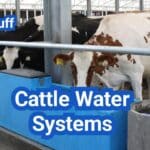The agricultural landscape is undergoing a significant transformation with the advent of vertical farming systems. By utilizing stacked layers, these innovative methods maximize space while minimizing environmental impact.
At the heart of these hydroponic systems are several key components: racks that provide structural support, LED grow lights that facilitate photosynthesis, and nutrient delivery systems that nourish crops. Together, these elements enhance crop yield and reduce the carbon footprint associated with traditional farming practices.
Key Takeaways
- Vertical farming maximizes space and reduces environmental impact.
- Key components include racks, LED grow lights, and nutrient delivery systems.
- These systems enhance crop yield and reduce carbon footprint.
- Hydroponic systems are a crucial part of vertical farming.
- LED grow lights facilitate photosynthesis in these controlled environments.
The Rise of Modern Agriculture
Modern agriculture has witnessed a significant transformation with the advent of vertical farming systems. This shift is driven by the need for more efficient and sustainable farming practices.
The Shift from Horizontal to Vertical Farming
Traditional farming methods rely on horizontal land use, which can be limited by factors such as land availability and climate. Vertical farming overcomes these challenges by utilizing vertical space, allowing for more crops to be grown in smaller areas. This method also enables farmers to control the environment more effectively, using climate control systems to optimize growing conditions.
Environmental and Economic Advantages
Vertical farming offers several environmental benefits, including reduced water consumption through automated irrigation systems and lower land use. Economically, it provides opportunities for increased crop yields and reduced transportation costs. As one expert notes,
“Vertical farming has the potential to revolutionize the way we produce food, making it more sustainable and locally accessible.”
By adopting vertical farming practices, farmers and businesses can capitalize on these advantages, contributing to a more sustainable food system.
Core Components of Vertical Farming Systems

Vertical farming’s potential is unlocked through the strategic deployment of essential infrastructure, including rack systems and nutrient delivery mechanisms. This method of farming is dependent on an ecosystem of specialized hardware that facilitates accuracy, effectiveness, and eco-friendliness.
Essential Infrastructure Elements
The backbone of any vertical farming system includes rack systems, which provide the structural framework for layering crops. Nutrient delivery systems are also crucial, as they supply plants with the necessary nutrients for growth. Additionally, lighting technologies, such as LED grow lights, play a vital role in providing the spectrum and intensity required for optimal plant development.
| Component | Function | Importance |
|---|---|---|
| Rack Systems | Structural framework for crop layering | High |
| Nutrient Delivery | Supplies necessary nutrients to plants | High |
| Lighting Technologies | Provides spectrum and intensity for plant growth | Critical |
How These Components Work Together
The synergy between rack systems, nutrient delivery, and lighting technologies is what makes vertical farming so effective. By optimizing these components, farmers can significantly enhance crop yield. For instance, precise nutrient delivery ensures that plants receive exactly what they need, while advanced lighting technologies promote healthy growth.
By understanding how these core components interact, vertical farming operators can create a highly efficient and productive growing environment.
Comparing Popular Vertical Farming Systems
The world of vertical farming encompasses a range of systems, from A-frame structures to warehouse-scale operations. These systems vary in their design, functionality, and application, catering to different needs and scales of operation.
A-Frame and Tower Systems
A-Frame and tower systems are popular for their space efficiency and ability to increase crop yield per square foot. These systems are ideal for precision agriculture, allowing for precise control over growing conditions. A-frame systems, with their triangular structure, are particularly useful for maximizing land use.
Tower systems, on the other hand, are vertically integrated, making them suitable for urban areas where space is limited. They can be equipped with advanced hydroponic or aeroponic systems, enhancing energy efficiency.
Stacked Horizontal Platforms
Stacked horizontal platforms offer flexibility and scalability, making them suitable for a wide range of crops. This system allows for easy access and maintenance, improving overall sustainability. The platforms can be adjusted according to the crop’s growth stage, optimizing space and resources.
These systems are often used in conjunction with LED lighting, which can be tailored to specific spectra for different crops, further enhancing precision agriculture practices.
Container and Warehouse-Scale Systems
Container and warehouse-scale systems represent the larger end of the vertical farming spectrum. These systems utilize shipping containers or entire warehouses, converted into controlled environment agriculture (CEA) facilities. They offer high levels of control over environmental conditions, contributing to sustainability and energy efficiency.
| System Type | Key Features | Benefits |
|---|---|---|
| A-Frame and Tower | Space-efficient, precision agriculture capable | High yield per square foot, energy efficient |
| Stacked Horizontal Platforms | Flexible, scalable, easy maintenance | Sustainable, adaptable to various crops |
| Container and Warehouse-Scale | High control over environment, large scale | Sustainable, energy efficient, high yield |
By understanding the different types of vertical farming systems, farmers and investors can make informed decisions about which system best suits their needs, balancing factors such as energy efficiency, sustainability, and the potential for precision agriculture.
Rack Systems: Structural Foundation Analysis
Rack systems form the backbone of modern vertical farming operations. These systems are designed to maximize space while ensuring the structural integrity and accessibility of the farming setup.
One of the primary considerations in designing rack systems is the choice between fixed and mobile rack designs. Fixed racks offer stability and are generally less expensive to install. However, they lack the flexibility that mobile racks provide, allowing for easier access and reconfiguration as needed.
Fixed vs. Mobile Rack Designs
Fixed racks are ideal for operations with a consistent layout, providing a sturdy framework for crop growth. Mobile racks, on the other hand, offer the advantage of adaptability, enabling farmers to adjust their setup in response to changing crop requirements or to accommodate new equipment.
| Feature | Fixed Racks | Mobile Racks |
|---|---|---|
| Cost | Lower initial cost | Higher initial cost |
| Flexibility | Limited flexibility | Highly flexible |
| Accessibility | Less accessible | Easier access |
Material Selection for Longevity and Safety
The selection of materials for rack systems is critical for ensuring longevity and safety. Materials must be durable, resistant to corrosion, and able to support the weight of the crops, growing media, and any additional equipment.
Galvanized steel and aluminum are popular choices due to their strength and resistance to corrosion. The choice of material can significantly impact the overall cost analysis and ROI of the vertical farming operation.
Optimizing Vertical Space with Strategic Rack Placement
Optimizing vertical space is crucial for maximizing the vertical farming benefits. Strategic rack placement involves considering factors such as light distribution, air circulation, and access for maintenance.
By carefully planning the layout and design of rack systems, farmers can significantly enhance their operation’s efficiency and productivity, ultimately improving their ROI.
Lighting Technologies: Performance and Efficiency

Vertical farming’s reliance on artificial lighting necessitates a careful examination of available technologies to optimize performance and efficiency. The right lighting can significantly enhance crop yields while minimizing energy consumption.
LED Systems: Spectrum Control and Energy Efficiency
LED grow lights are becoming increasingly popular in vertical farming due to their energy efficiency and ability to provide a targeted light spectrum. LEDs can be tailored to specific crop needs, enhancing growth rates and reducing energy waste. According to a study, LED lighting can reduce energy consumption by up to 40% compared to traditional lighting methods.
Alternative Lighting Options: Fluorescent and HPS
While LEDs are gaining prominence, other lighting technologies such as fluorescent and High-Pressure Sodium (HPS) lamps are still in use. Fluorescent lights are known for their cool operation and broad spectrum, making them suitable for certain crops. HPS lamps, on the other hand, are effective for flowering plants but tend to produce more heat, necessitating additional cooling measures.
| Lighting Technology | Energy Efficiency | Spectrum Control | Heat Output |
|---|---|---|---|
| LED | High | Excellent | Low |
| Fluorescent | Medium | Good | Medium |
| HPS | Low | Poor | High |
Light Placement Strategies for Uniform Growth
Effective light placement is crucial for uniform crop growth. Strategies include using reflective surfaces to minimize light loss and adjusting the height and spacing of lights to ensure even distribution. A well-designed lighting layout can significantly improve yields and reduce waste.
“The future of vertical farming lies in its ability to integrate advanced technologies like LED lighting with precise control systems to create optimal growing conditions.”
— Expert in Vertical Farming
By understanding and implementing the most efficient lighting technologies and strategies, vertical farmers can enhance productivity while reducing operational costs.
Nutrient Delivery Systems Compared
Optimizing nutrient delivery is key to achieving high productivity in vertical farming setups. Nutrient delivery systems are the backbone of vertical farming, providing plants with the necessary nutrients for growth. The choice of nutrient delivery system can significantly impact crop yields and overall farm efficiency.
Hydroponic Methods: NFT, DWC, and Drip Systems
Hydroponic systems are a popular choice for vertical farming, offering precise control over nutrient delivery. There are several hydroponic methods, including Nutrient Film Technique (NFT), Deep Water Culture (DWC), and drip systems. NFT involves a continuous flow of nutrient-rich solution over the roots, while DWC suspends roots in a nutrient-rich solution. Drip systems deliver nutrients directly to the base of the plants.
NFT systems are known for their water efficiency and ability to support high plant densities. However, they require precise control over nutrient levels and can be susceptible to root clogging. DWC systems are simpler to set up and maintain, offering a stable environment for root growth. Drip systems are versatile and can be used with a variety of growing media.
Aeroponic Misting: Benefits and Challenges
Aeroponic systems deliver nutrients through a fine mist, providing plants with a highly oxygenated environment. This method promotes rapid growth and can be highly water-efficient. However, aeroponic systems require precise control over misting intervals and can be sensitive to clogging.
The benefits of aeroponic misting include increased oxygenation and reduced water usage. Challenges include the need for precise misting control and potential issues with root clogging.
Aquaponic Integration: Creating Symbiotic Ecosystems
Aquaponic systems integrate hydroponics with aquaculture, creating a symbiotic ecosystem where fish and plants coexist. Fish waste provides nutrients for the plants, while the plants help purify the water for the fish. This closed-loop system can be highly sustainable and productive.
| Nutrient Delivery System | Water Efficiency | Nutrient Control | Complexity |
|---|---|---|---|
| NFT Hydroponics | High | Precise | Medium |
| DWC Hydroponics | Medium | Simple | Low |
| Aeroponics | High | Precise | High |
| Aquaponics | High | Complex | High |
In conclusion, the choice of nutrient delivery system depends on the specific needs and goals of the vertical farming operation. By understanding the benefits and challenges of each system, farmers can make informed decisions to optimize their crop yields and overall efficiency.
Environmental Control Technology

Environmental control systems play a pivotal role in modern vertical farming by ensuring optimal growing conditions. These systems are designed to create a precise environment that fosters healthy plant growth, regardless of external weather conditions.
Temperature Management Solutions
Temperature control is critical in vertical farming, as it directly affects plant growth rates and crop yields. Heating, ventilation, and air conditioning (HVAC) systems are commonly used to maintain optimal temperatures between 65°F to 75°F (18°C to 24°C) during the day and slightly cooler temperatures at night.
- Precision temperature control allows for optimal growth conditions.
- Energy-efficient HVAC systems reduce operational costs.
Humidity Regulation Systems
Maintaining the right humidity levels is essential to prevent water stress and reduce the risk of fungal diseases. Humidification and dehumidification systems work together to keep relative humidity levels between 40% to 60%, ideal for most crops.
- Humidification systems add moisture to the air when necessary.
- Dehumidification systems remove excess moisture.
Air Circulation and CO2 Enrichment
Air circulation is vital for distributing heat and CO2 evenly throughout the vertical farm. CO2 enrichment enhances photosynthesis, leading to faster growth rates and higher yields. Fans and air circulation systems ensure that CO2 is distributed uniformly.
By integrating these environmental control technologies, vertical farms can significantly improve crop quality and yield while minimizing environmental impact. The use of advanced climate control systems represents a significant farming innovation, enabling more efficient and sustainable agricultural practices.
Automation and Monitoring Solutions

The integration of automation and monitoring solutions is transforming the vertical farming landscape. Automation plays a pivotal role in enhancing the efficiency and scalability of vertical farming. By leveraging advanced technologies, farmers can optimize growing conditions, reduce labor costs, and improve crop yields.
Sensor Networks for Real-Time Data
Sensor networks are crucial for collecting real-time data on environmental conditions such as temperature, humidity, and light intensity. This data enables farmers to make informed decisions and adjust their farming strategies accordingly. Some key benefits of sensor networks include:
- Enhanced precision in monitoring and controlling environmental conditions
- Improved crop health and yield through data-driven decisions
- Reduced labor costs through automated data collection
Automated Nutrient and pH Management
Automated nutrient and pH management systems ensure that crops receive the necessary nutrients in the right proportions. These systems can significantly reduce the risk of nutrient deficiencies and pH imbalances, leading to healthier crops and higher yields. Key features include:
- Precise control over nutrient delivery
- Automated pH adjustment to optimal levels
- Integration with sensor data for real-time adjustments
Climate Control Systems and IoT Integration
Climate control systems, integrated with IoT technology, allow for precise control over the growing environment. This includes temperature, humidity, and CO2 levels. The benefits of such integration include:
- Enhanced control over growing conditions
- Improved crop resilience and yield
- Remote monitoring and control capabilities
By adopting automation and monitoring solutions, vertical farmers can significantly enhance their operation’s efficiency and productivity. As the industry continues to evolve, the role of smart farming technologies will become increasingly vital.
Cost Analysis of Vertical Farming Systems

The cost analysis of vertical farming systems reveals a complex interplay of initial investments, operational costs, and potential returns. Understanding these financial aspects is crucial for entrepreneurs and investors looking to capitalize on this innovative agricultural method.
Initial Investment Requirements
The initial investment for a vertical farming system can be substantial, including costs for infrastructure such as racks, lighting, and climate control systems. For instance, LED lighting, which is energy-efficient, can be a significant upfront cost. The average cost for setting up a basic vertical farm can range from $100,000 to over $1 million, depending on the scale and technology used.
Key components influencing initial costs include:
- Land acquisition or leasing
- Building or renovating facilities
- Lighting and climate control systems
- Hydroponic or aeroponic systems
Operational Expenses Breakdown
Operational expenses in vertical farming include energy consumption, water usage, nutrient supply, and labor costs. Energy costs, particularly for lighting and climate control, can be significant. However, energy-efficient technologies can help mitigate these expenses. Labor costs vary based on the level of automation implemented in the farm.
ROI Calculations and Payback Periods
Calculating the Return on Investment (ROI) for vertical farming involves comparing the net profits to the total investment costs. The payback period, which is the time taken for the investment to generate returns equal to its initial cost, is a critical metric. With proper planning and efficient operations, many vertical farms achieve a payback period of 3 to 5 years.
Efficient management of costs and maximizing farm productivity are key to achieving a favorable ROI.
Space Optimization Techniques

To achieve maximum productivity, space optimization techniques are essential in vertical farming. By efficiently utilizing available space, vertical farms can significantly increase their yield per square foot, making the operation more profitable and sustainable.
Vertical Space Utilization Strategies
Efficient use of vertical space is a hallmark of successful vertical farming. This can be achieved through the use of multi-tiered rack systems, which allow for the cultivation of multiple layers of crops. By maximizing vertical space, farms can grow more crops in a smaller footprint, reducing the overall cost per unit of produce.
Plant Spacing and Density Considerations
Proper plant spacing and density are critical factors in optimizing space in vertical farms. Overcrowding can lead to reduced growth rates and increased susceptibility to disease, while underutilization of space can result in inefficiencies. By carefully planning the layout and density of crops, farmers can maximize yield while maintaining healthy growing conditions.
| Crop Type | Optimal Spacing | Density per Square Meter |
|---|---|---|
| Leafy Greens | 10-15 cm | 40-60 plants |
| Herbs | 5-10 cm | 80-100 plants |
| Strawberries | 20-25 cm | 20-25 plants |
Crop Selection for Maximum Yield

Effective crop management begins with selecting crops that are well-suited for vertical farming systems. The right crop selection can significantly enhance yield, improve profitability, and meet market demand.
High-Value Crops for Vertical Systems
High-value crops such as leafy greens, herbs, and strawberries are particularly well-suited for vertical farming. These crops not only command high prices in the market but also thrive in controlled environments. Leafy greens, for example, have a short growth cycle and can be harvested multiple times, increasing their profitability.
Growth Cycle and Harvest Planning
Understanding the growth cycle of crops is crucial for planning harvests and ensuring a continuous supply to the market. Crops with shorter growth cycles can be planted more frequently, allowing for a steady stream of produce. Succession planting is a strategy used to maximize yield by staggering planting dates.
| Crop | Growth Cycle (Days) | Harvest Frequency |
|---|---|---|
| Leafy Greens | 20-30 | Weekly |
| Herbs | 30-40 | Bi-Weekly |
| Strawberries | 60-90 | Monthly |
Market Demand and Profitability Factors
Market demand plays a significant role in determining the profitability of crops in vertical farming. Crops that are in high demand and have a strong market presence are more likely to generate higher returns. Understanding local market trends and consumer preferences is essential for making informed decisions about crop selection.
By carefully selecting high-value crops, planning growth cycles, and responding to market demand, vertical farmers can maximize their yield and profitability.
Step-by-Step Implementation Guide

To successfully implement a vertical farming system, one must carefully consider several key factors, including system design and component selection. This guide will walk you through the essential steps to establish a thriving vertical farm.
System Design and Planning
The first step in implementing a vertical farming system is designing the layout and infrastructure. This involves determining the size of the facility, the type of crops to be grown, and the precision farming techniques to be employed. Careful planning is crucial to ensure optimal crop yield and resource efficiency.
Key considerations during the design phase include the available space, climate control requirements, and the type of farm automation systems to be integrated. A well-designed system will maximize vertical space while maintaining accessibility for maintenance and harvesting.
Component Selection and Sourcing
Once the system design is finalized, the next step is to select and source the necessary components. This includes LED lighting systems, irrigation and nutrient delivery systems, climate control equipment, and monitoring sensors. It’s essential to choose high-quality components that are compatible with each other and meet the specific needs of your crops.
Sourcing components from reputable suppliers is critical to ensure reliability and performance. Consider factors such as energy efficiency, durability, and scalability when making your selections.
Installation and Testing Procedures
The installation process involves setting up the vertical farming infrastructure, including the racking systems, lighting, and climate control equipment. It’s crucial to follow the manufacturer’s instructions and industry best practices to ensure a successful installation.
After installation, thorough testing is necessary to verify that all components are functioning correctly. This includes checking the irrigation and nutrient delivery systems, climate control, and monitoring sensors. Testing ensures that the system is ready for crop production and helps prevent potential issues down the line.
Maintenance and System Management
To ensure optimal performance, vertical farming operations must prioritize rigorous maintenance and system management. This involves a multi-faceted approach that includes daily monitoring, preventative maintenance, and thorough cleaning protocols.
Daily Monitoring Protocols
Daily checks are vital to identify any potential issues before they escalate. This includes monitoring temperature, humidity, and CO2 levels, as well as inspecting equipment for any signs of malfunction. Regular monitoring enables farmers to make timely adjustments, ensuring optimal growing conditions.
Preventative Maintenance Schedule
A well-planned preventative maintenance schedule is crucial for minimizing downtime and extending the lifespan of equipment. This includes tasks such as replacing worn-out parts, lubricating moving components, and updating software. By adhering to a regular maintenance schedule, farmers can prevent unexpected failures and maintain productivity.
Cleaning and Sanitization Requirements
Farm hygiene is paramount in vertical farming to prevent the spread of diseases and pests. Regular cleaning and sanitization of growing areas, equipment, and irrigation systems are essential. This not only protects the crops but also ensures the overall health and safety of the farm environment. As noted by industry experts, “Maintaining a clean and sanitized environment is critical for the success of vertical farming operations.”
Advancing Your Vertical Farming Operation
As the world grapples with the challenges of feeding a growing population, vertical farming emerges as a beacon of hope for sustainable farming and urban agriculture. By leveraging cutting-edge farming innovation, such as advanced rack systems, optimized lighting technologies, and precise nutrient delivery methods, farmers can significantly enhance crop yields while minimizing environmental impact.
The key to a successful vertical farming operation lies in understanding and effectively utilizing its core components. By doing so, farmers can create controlled environments that foster healthy plant growth, reduce water consumption, and eliminate the need for pesticides and herbicides.
As technology continues to advance, it’s crucial for farmers to stay informed and adapt to new methods and equipment. This not only ensures the long-term viability of their operations but also contributes to the broader goal of creating a more sustainable food system. By embracing the principles of vertical farming, we can move closer to achieving a future where urban agriculture thrives, and communities have access to fresh, locally grown produce.
FAQ
What are the core components of a vertical farming system?
The core components of a vertical farming system include racks, lighting, and nutrient delivery systems, which work together to create an optimal growing environment.
What are the benefits of adopting vertical farming practices?
Vertical farming offers several benefits, including reduced land use, water consumption, and environmental impact, as well as increased crop yields and economic advantages.
What types of lighting technologies are used in vertical farming?
LED systems are a popular choice for vertical farming due to their energy efficiency and spectrum control, although alternative lighting options like fluorescent and HPS are also used.
How do nutrient delivery systems work in vertical farming?
Nutrient delivery systems, including hydroponic, aeroponic, and aquaponic methods, provide plants with the necessary nutrients for growth, and can be tailored to specific crop requirements.
What is the importance of environmental control technology in vertical farming?
Environmental control technology, including temperature management, humidity regulation, and air circulation, is crucial for maintaining optimal growing conditions and maximizing crop yields.
How can automation and monitoring solutions improve vertical farming operations?
Automation and monitoring solutions, such as sensor networks and automated nutrient management, can help optimize growing conditions, reduce labor costs, and improve crop yields.
What are the initial investment requirements for a vertical farming system?
The initial investment required for a vertical farming system can vary widely, depending on the size and complexity of the operation, as well as the specific components and technologies used.
How can space be optimized in a vertical farming system?
Strategies for optimizing space in vertical farming include using vertical space utilization techniques, such as stacked growing systems, and carefully planning plant spacing and density.
What factors influence crop selection in vertical farming?
Crop selection in vertical farming is influenced by factors such as market demand, growth cycle planning, and profitability considerations, as well as the specific conditions and constraints of the growing environment.
What are the key considerations for implementing a vertical farming system?
Key considerations for implementing a vertical farming system include system design, component selection, and installation procedures, as well as ongoing maintenance and system management.
How can maintenance and system management be optimized in vertical farming?
Maintenance and system management can be optimized through daily monitoring, preventative maintenance scheduling, and regular cleaning and sanitization protocols.
What are the benefits of using rack systems in vertical farming?
Rack systems provide a structural foundation for vertical farming, allowing for efficient use of space, improved crop yields, and reduced labor costs.
How do different types of vertical farming systems compare?
Different types of vertical farming systems, such as A-frame and tower systems, stacked horizontal platforms, and container and warehouse-scale systems, offer varying advantages and disadvantages, and can be chosen based on specific needs and goals.
Conclusion of: Vertical Farming Systems
Vertical Farming Systems: What They Are and Why They Matter
Vertical farming systems are engineered, climate-controlled farms that stack crops on multi-tier racks and grow them under carefully managed light, temperature, humidity, nutrients, and hygiene. For U.S. growers, vertical farming systems promise reliable year-round output near cities, with tight control over quality and food safety. University of Arizona CEAC: What is a Vertical Farm?
How Vertical Farming Systems Differ From Greenhouses and Field Farms
Unlike field production, vertical farming systems operate in enclosed buildings, using electricity for lighting and HVAC instead of sunlight and ambient weather. Compared with many greenhouse models, vertical farming systems depend more on sole-source LEDs and dehumidification, trading weather risk for energy cost and precision. Peer-reviewed work comparing hydroponics with conventional cultivation shows large water savings but higher energy intensity—an important context for vertical farming systems. Barbosa et al., 2015 (Int. J. Environ. Res. Public Health)
Core Building Blocks of Vertical Farming Systems
Well-designed vertical farming systems bring together four pillars: (1) racking/trays and cleanable surfaces, (2) horticultural LED lighting, (3) HVACD—heating, ventilation, air-conditioning, and dehumidification, plus CO₂ management, and (4) recirculating hydroponic nutrient delivery with rigorous sanitation. Each pillar in vertical farming systems is sized from crop requirements (light, temperature, VPD, CO₂, EC/pH) and verified with sensors and data logging. U.S. DOE: Lighting Market Characterization—Horticulture
Racks, Benches, and Trays: Designing for Strength and Cleanability
Because vertical farming systems stack weighty water, plants, and hardware, benches and channels must resist deflection and allow slope for drainage; materials should avoid corrosion and be easy to sanitize. Practical extension guides for nutrient film technique (NFT) show typical support layouts, reservoir placement, slopes, and materials—useful patterns when specifying racks for vertical farming systems. Virginia Tech Extension: NFT Systems (SPES-463)
Food-Grade Design and Regulatory Baseline
Beyond crop performance, vertical farming systems are food facilities; they should align with the FDA’s Produce Safety Rule for water use, sanitation, and hygienic design to minimize contamination, especially in recirculating systems. Clear responsibilities for agricultural water, cleaning, and worker practices help vertical farming systems meet buyer and regulatory expectations. FDA: FSMA Final Rule on Produce Safety
Horticultural LEDs: The Engine of Vertical Farming Systems
Because vertical farming systems seldom rely on sunlight, LED fixtures define cost, yield, and quality. Specify by plant metrics—PPF/PPFD and photosynthetic photon efficacy (µmol·J⁻¹)—not just watts. Align spectrum and intensity with crop targets to avoid under- or over-lighting in vertical farming systems, and leverage efficiency gains documented by national programs. U.S. DOE: Horticultural Lighting Market Characterization
DLI, PPFD, and Photoperiod: Hitting Light Targets
Daily Light Integral (DLI) translates PPFD and photoperiod into a daily “mol of light” target; it’s the most practical way to size lights in vertical farming systems. Use university tools to set DLI targets, then back-solve PPFD and hours that vertical farming systems must deliver for each growth stage. UF/IFAS: Daily Light Integral App & Training
U.S. Maps and Measurement for Light Planning
Even when vertical farming systems rely on LEDs, outdoor DLI maps and measurement primers help teams understand seasonal variability for supplemental or hybrid builds, and teach staff how to measure PPFD/DLI correctly—skills that carry over to validating light plans inside vertical farming systems. MSU: U.S. Daily Light Integral (DLI) Maps
Program Standards and Rebates for Grow Lights
When selecting fixtures for vertical farming systems, check program eligibility lists and technical requirements to access utility rebates and ensure safety/testing rigor; this can materially improve ROI for vertical farming systems deploying thousands of luminaires. DesignLights Consortium: Horticultural Technical Requirements
Hydroponic Options: Choosing the Right Fit
Nutrient delivery is the heartbeat of vertical farming systems. Common choices include NFT and deep-water culture (DWC) for leafy greens, and media-based drip for heavier crops. The best fit for vertical farming systems depends on crop, labor flow, and sanitation strategy. Penn State Extension: Hydroponics Systems & Principles
When NFT Shines in Vertical Farming Systems
NFT channels give high water- and space-use efficiency with fast turns, which is why many leafy-green vertical farming systems prefer it. Proper slopes, flow rates, and easy-to-clean channels are critical to keep films uniform and biofilms at bay in these vertical farming systems. UF/IFAS EDIS: Hydroponic Vegetable Production in Florida
Media-Based and DWC Choices
Media beds and DWC can buffer temperature and EC, sometimes suiting beginners or specific crops in vertical farming systems; however, they require vigilant aeration and sanitation plans to prevent root disorders in recirculating vertical farming systems. University of Minnesota Extension: Small-Scale Hydroponics
Water, Sanitation, and Reuse
Closed-loop water is an advantage of vertical farming systems, but only with disciplined disinfection. Chlorination, UV, and filtration are established tools to manage microbes in the nutrient loop of vertical farming systems—implemented with documented procedures and logs. University of Arizona Extension: Disinfection of Irrigation Water—Chlorination
Regulatory Focus on Agricultural Water
Vertical farming systems that use water for growing, harvesting, or post-harvest handling fall under specific FSMA water standards, including recent updates requiring systems-based pre-harvest water assessments; aligning SOPs in vertical farming systems with these rules reduces risk and audit friction. FDA: Harvest & Post-Harvest Agricultural Water (Subpart E)
Strategic Water Reuse in Vertical Farming Systems
With proper treatment, some facilities integrate water reuse strategies to reduce withdrawals and discharge; evaluating local regulations and treatment performance is essential before implementing water reuse in vertical farming systems. EPA: Reusing Water for Agricultural Activities
Humidity, VPD, and Dehumidification
Transpiration from stacked canopies loads the air with moisture; vertical farming systems therefore manage vapor-pressure deficit (VPD) rather than relative humidity alone. Correct VPD keeps leaves dry, nutrients flowing, and disease pressure low in vertical farming systems. MSU Floriculture: Water Vapor-Pressure Deficit (VPD)
Practical VPD Targets for Vertical Farming Systems
Propagation prefers a lower VPD; finishing often benefits from a moderate VPD to balance growth and disease control. These principles translate well into sealed grow rooms where vertical farming systems rely on tight HVACD control. MSU Extension: Why Track VPD?
CO₂ Enrichment and Air Movement
Because sealed rooms can deplete daytime CO₂, vertical farming systems often supplement to ~800–1,000 ppm when lights are on, coordinated with airflow to distribute gases uniformly; done right, this improves light-use efficiency in vertical farming systems. Oklahoma State Extension: CO₂ Supplementation
Lighting and CO₂—An Integrated Control Strategy
CO₂ is most effective when light is adequate; vertical farming systems should integrate dimming, photoperiods, and CO₂ setpoints so plants can use the extra carbon. Research groups provide practical curves and guidance that apply directly to vertical farming systems. GLASE Technical Report: Light × CO₂ Control
Nutrient Management: EC, pH, and Recipes
Stable electrical conductivity (EC) and pH are non-negotiable for vertical farming systems. Start with proven recipes, then adjust based on tissue tests and growth; maintain clean tanks and instruments so measurements in vertical farming systems stay trustworthy. Penn State Extension: Nutrient Solution Programs & Recipes
Energy Use and the ROI Equation
Energy—mostly from lights and dehumidification—dominates operating costs in many vertical farming systems. Use metered kWh, fixture efficacy, and local tariffs to compute cost per mol of delivered light and per pound of saleable yield in vertical farming systems, then pursue incentives where eligible. U.S. DOE: Horticultural Lighting—Market & Energy Data
Budgeting Lighting Costs in Vertical Farming Systems
A simple, research-based approach is to translate your PPFD and photoperiod into DLI, then estimate kWh and cost under real tariffs; this helps avoid under- or over-specifying fixtures in vertical farming systems and clarifies payback on controls like dimming. UF/IFAS: Economics of Lighting Young Plants Indoors
Food Safety Programs for Vertical Farming Systems
Written SOPs for cleaning, water verification, worker hygiene, and environmental monitoring help vertical farming systems satisfy customer audits and FSMA inspections; schedule verification, record-keeping, and corrective actions just as you would in any food facility built on vertical farming systems. FDA: Produce Safety Inspections—What to Expect
Crop Choice and Market Fit
Profitability in vertical farming systems is crop- and market-specific. Quick-turn leafy greens and herbs often pencil first due to short cycles and dense stacking, while fruiting crops require different economics; pilot small, measure, and scale what works in your vertical farming systems. University of Minnesota Extension: Hydroponics Overview
Getting Started: A Practical Checklist
To de-risk a launch, build a one-bay pilot for your vertical farming systems: validate recipes, VPD control, fertigation routines, cleaning schedules, and labor time per tray. Use recognized tools (DLI calculators, light maps, nutrient recipes) so that scaling your vertical farming systems is a matter of replication—not reinvention. UF/IFAS EDIS: Florida Greenhouse Design (concepts & controls)
Where Water and Sustainability Meet
Many operators design vertical farming systems to minimize withdrawals and discharge with treatment, reuse, and careful nutrient stewardship. Review federal and state resources to ensure any reuse practices in vertical farming systems meet local requirements. EPA: Agricultural Water Reuse Resources
Final thought
For growers who prize consistency, proximity to consumers, and clean supply chains, vertical farming systems can be compelling—provided you engineer light, climate, water, and sanitation with the same rigor as a food plant. Start with a data-driven pilot, use credible agronomic targets, and let measurements—not marketing—guide the scale-up of your vertical farming systems. University of Arizona CEAC: Vertical Farm Overview
Sources & References
- Barbosa et al., 2015: Hydroponics vs Conventional—Water/Energy/Yield
- UF/IFAS: Daily Light Integral App & Training
- MSU: U.S. DLI Maps (Faust et al.)
- DesignLights Consortium: Horticultural Technical Requirements
- Penn State Extension: Hydroponics Systems & Principles
- UF/IFAS EDIS: Hydroponic Vegetable Production in Florida
- Virginia Tech Extension: NFT Systems (SPES-463)
- FDA: FSMA Final Rule on Produce Safety
- FDA: Subpart E—Harvest & Post-Harvest Water
- FDA: Produce Safety Inspections
- EPA: Water Reuse—Agricultural Activities
- MSU: VPD Resource
- MSU Extension: Why Track VPD?
- Oklahoma State Extension: CO₂ Supplementation
- GLASE: Plant Responses to Integrated Light and CO₂ Control
- UF/IFAS: Economics of Indoor Lighting
- UF/IFAS EDIS: Florida Greenhouse Design (controls concepts)

